“The new digital landscape has opened up the entire world to comics” Aussie comic creators Pat McNamara and David G Williams discuss taking over the world with The Legend of Space Lord Mo Fo
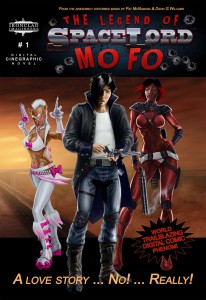 One of the great things about our digital comic of the year poll was that it enabled comics creatives to get together and share their love for digital comics with each other and champion their favourites. As well as discovering the fantastic Aces Weekly, our attention was also drawn to the brilliantly titled SpaceLord Muthaf**ka (aka SpaceLord MoFo) from Aussie writer Pat McNamara and artist David G Williams, aka the Ironclad Imagineers. Inspired by the likes of Mark Waid’s Thrillbent website this digital only title was initially released in bite-size chunks via their own site, but as of this month is also available via DriveThru Comics as an interactive PDF – or rather digital cinegraphic novel. Best viewed using a PDF reader that allows you to cycle through the pages, it brilliantly mixes the interactive elements of books like Powerplay and Insufferable, with the motion elements of Madefire and adds in a politically incorrect Aussie attitude for good measure. So what kind warped minds could come up with such an outlandish concept, we contacted Dave and Pat to find out.What made you want to start Space Lord? Was it all about making a digital comic or did you have the idea floating around for a while in other formats?
One of the great things about our digital comic of the year poll was that it enabled comics creatives to get together and share their love for digital comics with each other and champion their favourites. As well as discovering the fantastic Aces Weekly, our attention was also drawn to the brilliantly titled SpaceLord Muthaf**ka (aka SpaceLord MoFo) from Aussie writer Pat McNamara and artist David G Williams, aka the Ironclad Imagineers. Inspired by the likes of Mark Waid’s Thrillbent website this digital only title was initially released in bite-size chunks via their own site, but as of this month is also available via DriveThru Comics as an interactive PDF – or rather digital cinegraphic novel. Best viewed using a PDF reader that allows you to cycle through the pages, it brilliantly mixes the interactive elements of books like Powerplay and Insufferable, with the motion elements of Madefire and adds in a politically incorrect Aussie attitude for good measure. So what kind warped minds could come up with such an outlandish concept, we contacted Dave and Pat to find out.What made you want to start Space Lord? Was it all about making a digital comic or did you have the idea floating around for a while in other formats?
Pat: I’d had the idea for the Mo Fo percolating in my head for quite a few years, but I hadn’t found time to develop it as I work pretty much full time for Angel Phoenix Media developing concepts, and writing novels and TV pilots. When a break in projects came along, the bug to do something of my own bit me hard – and the Mo Fo was calling out loudest for attention. I’d always wanted to do a comic, so I dove in and wrote a ten page teaser script, and contacted David, who I had worked with on and off for about fifteen years. I pitched him the idea of doing The Legend of Spacelord Mo Fo as a low-production cost webcomic, similar in format to Travest Charest’s ‘Spacegirl’ strip, and he said…
Dave: Hell yeah!
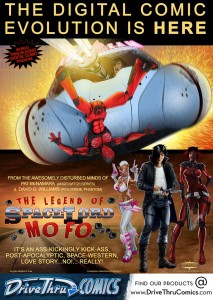 You’ve just made a digital download version available via DriveThru Comics, what can we expect from this new venture?
You’ve just made a digital download version available via DriveThru Comics, what can we expect from this new venture?
Pat: We made the decision at the beginning to embrace having a free version of the comic for readers, but, to keep some incentive to buy the comic, we kept the free version at the lower res 1024 x 576, and have the sale version at 1920 x1080. At present, both the free and the DriveThru versions are pdf files, which the reader can open in a suitable program and click through on their PC or Mac, though, I’d recommend viewing the HD version on a 50″ inch plasma if possible. Viewing on Tablets and phones is still problematic, as most seem hardcoded to using the ‘swipe’ function to change pages, which doesn’t actually work for a Digital Comic in .pdf format like ours, or Insufferable. We’re still exploring our options in this regard, and we may look at creating a dedicated app for future releases, but we’re limited by resources at present – one of the joys of being an Indie Creator/Publisher.
How do you plan the pages? Do you write story and then split it up or just write what feels right? The first few installments on the website take a while to get going, was that intentional or was it just you finding your feet in terms of pacing?
Pat: Once we decided to do the comic, I finished the script for what’s now become Episodes 1 – 3. My draft was written like a TV screenplay as opposed to a conventional comic book script format, since I’d never envisioned it being a traditional comic book. So, when Dave and I sat down and started brainstorming how we were going to illustrate the different scenes, the jump from a simple strip webcomic, to a truly digital comic was a fairly natural one. Coming from a games background was also a help for me too. Where there seems to be some resistance to change in comics, games are all about pushing the creative and technological envelope – so, taking comics from print and paper into the emerging digital medium seemed like an obvious next step in the creative process to me. I’m still surprised more creators aren’t exploring the digital medium.
Dave: When we first began planning the pages we came very quickly to the realization that we were faced with different boundaries in what we were attempting. With the script in a screenplay format and seemingly no restriction to panel numbers, this lead to early experimentation and figuring out what benefits and limitations we were faced with. The beginning of Episode One was intentionally a slow panning shot in homage to Sergio Leone’s spaghetti westerns. This is when we began throwing ideas about for a new term for what we were doing and so our ‘Digital Cinegraphic Novel’ was born.
I love the mix of art styles, what are your influences? 2000ad, Lobo and Simon Bisley seem the obvious ones? What apps do you use for drawing and Space Lord in and why?
Dave: Fully painted comics have always been what appealed to me most. The work of Bisley and Glenn Fabry are a fine example and then there’s Steve Pugh. Ever since picking up ‘Hotwire’ I was utterly blown away by the art and stunned he had produced such textural and natural work digitally. This lead to my slow transition from traditional methods of working to going fully digital. I now use Photoshop from first sketch to final production and illustrate on a Cintiq 12WX.
The flashback scenes in Spacelord Mo Fo give us the opportunity to step back to a more traditional style of comic art. Our first involving an Icecream Skyvan, Anizons, missiles, explosions and… well… you need to read it to believe it.
Cosplay has also had a great influence in the development of the characters and story. The concept of gangs of Cosplayers with real guns and working tech just seems natural. It does to us at least.
Pat: Er… Hell yeah!
Which other digital comics do you rate and why? What do you think of titles like Insufferable and the various Madefire titles?
Pat: There seems to be two different design methods of new Digital Comics emerging. There’s those following the more traditional comic format of static art on the digital page without any sound and movement, like Insufferable, Infinite Nova, and Spacelord Mo Fo. Then there’s comics like Ryan Woodward’s Bottom of the Ninth, and the Madefire titles, which have added an extra dimension to their storytelling by enhancing it with sound and movement, but have learnt the lesson that came from the failure of the earlier wave of Motion Comics which is to leave control in the hands of the reader. I’m excited by both methods, thought there still aren’t a lot of either out there yet.
Of the non-enhanced digital comics I’m pretty much reading everything I can find – Insufferable, Power Play, Hero by Night, Relaunch, City of the Dead, Pax Arena – and I’m loving seeing what other creators are doing. It’s an amazing time to literally be watching this comic evolution take place before our eyes. My favorite though, would be Mark Waid and Yves Bigeral’s work on Infinite Nova and AvsX 6. To me, those two comics have been the most dynamic and successful in their use of the medium in their storytelling. That said, everything Waid and Bigeral have been doing in digital deserves a huge shout out.
Of the enhanced comics, Bottom of the Ninth is a visual treat, and of the daunting range of comics on Madefire, Mono really appealed to me, partly because of the Castle Wolfenstein vibe, but mostly it’s the engaging flow and powerful delivery of the art and story. Treatment’s also pretty damn cool.
I also just discovered the sci-fi epic, Anomaly, which looks like a pretty impressive mix of digital and traditional print techniques.
All that said, the new tools that the digital medium offers artists and writers is like CGI in movies, it can have a great ‘Wow!’ factor, but if it’s not used in the service of the storytelling, then it simply becomes a novelty for readers, and novelty doesn’t have a long shelf life. I think Motion Comics proved that.
Dave: My personal favorite belong to Yves Bigeral (Balak) with his first experimentation in the digital format with ‘About Digital Comics’ and followed up by ‘About About Digital comics’ which you can find on DeviantArt.com. This lays out the rules and possibilities beautifully. The Thrillbent comics have taken this form of storytelling and have been essential in the growth of digital comics. The Madefire comics are a great example of how far you can push the limits. The future is certainly looking bright.
Give us a bit of info about your backgrounds in comics and what other work of yours that readers should check out?
Dave: I began in comics in the early nineties being employed as a background artist for Glenn Lumsden on the Phantom for Marvel Comics. From there I worked with Michal Dutkiewicz on Batman: Shadow of the Bat, Catwoman: Annual 1996, R.E.B.E.L.S, Wolverine: Doombringer before taking the step out to working independently on titles such as ‘In Flesh and Spirit’ (available through OvertoneComics.com) and ‘The Wolf’s Empire’ (in development) with Claudia Christian (Babylon 5) and Morgan Grant Buchanan. This lead to collaborating with Pat on ‘The Legend of Spacelord Mo Fo’, which is our little baby. Actually, it’s not so little anymore!
Pat: I’ve been hooked on comics since I was six and my uncle dropped a stack of Uncanny X-Men, Fantastic Four, Thor, and Iron Man comics in my lap and said, ‘Enjoy!’. My Dad was also a writer/editor and small press sci-fi publisher, so creativity’s in my blood you could say. As a writer, I started out in games. I was a co-owner and lead writer/game designer for R3 Interactive, a small games company, for about ten years – during that time, I was also writing my own film and TV scripts on the side. When R3 closed, I fell into a job as an assistant to comic artist, Michal Dutkiewicz (Wolverine, Superman, Catwoman, Batman Forever), and that led me to working as a colorist for him on Lost in Space: Voyage to the Bottom of the Soul. When Lost in Space finished, Michal was approached to do illustration work for Angel Phoenix Media, who also needed a writer. I gave them some sample scripts, and got the job. I’ve developed several TV and Film properties for APM, but the biggest project to date has been the Angelwitch Illustrated Novel Series with Michal. The first book in the series, Dragonscarpe, is being launched in a couple of months – www.facebook.com/angelphoenixmedia .
What’s the grand plan? How much is planned out and when do we get chapter 2? Any plans to release a print version or is it all about digital?
Pat: We do have a plan for the Mo Fo. Episode 1 is the first part of a three Episode arc, that acts as the ‘Pilot‘ to the series. It sets up our two main characters, Bran and Honey, and gives readers a sense of the nasty post-apocalyptic galaxy they live in, and introduces the first piece of the puzzle at the heart of the story, that is the seemingly mythic figure feared throughout the galaxy, ‘Spacelord Muthaf#*ker’… aka ‘Mo Fo‘. We’re also playing on a pretty broad tonal canvas, so there’s darkness, and horror, and funny, and love, and guns… lots of guns. Beyond the ‘Pilot‘, we have ‘Season 1‘ planned out – and, if we’ve got the fans and the fates on our side, then there’s another five seasons floating around in my head to explore after that. So… yeah… the plans are grand 🙂
Dave: Episode 2 is in the development stage with concept art and world domination in the works. We have discussed a number of concepts as to how we could produce a print version but are currently sticking to digital only. As far as planning goes… phew… I’ve got years of work ahead of me. This universe that Pat has concocted is huge!
Does digital make it easier for Aussies like yourself to make your title successful worldwide? How wide does your audience spread? How has it been received?
Dave: Digital certainly does open a number of doors that were previously shut or very difficult to navigate in the past. We have the pleasure of this interview via our connection through the web and this is what allows us a personal connection to all those around the world who enjoy the Mo Fo. The reception has been very positive across the board. Currently, we have been only attending Aussie cons although we are looking forward to exporting ourselves to cons around the globe at some stage.
Pat: I think when people look back on this evolution of comics, they won’t just see the change in mediums and storytelling techniques, but they’ll also talk about how the new digital landscape has opened up the entire world to comics. That said, digital can’t replace meeting fans and other creators in the real world, so, as Dave said, we really want to get over to some of the big comic shows in the US and the UK and give people a first-hand introduction to the MoFoverse.
The first instalment of The Legend of Space Lord Mo Fo can be downloaded for free at www.spacelordmofo.com or as a digital cinegraphic novel at DriveThru Comics for just $1.99. To find out more visit their Facebook page or check out read their blog
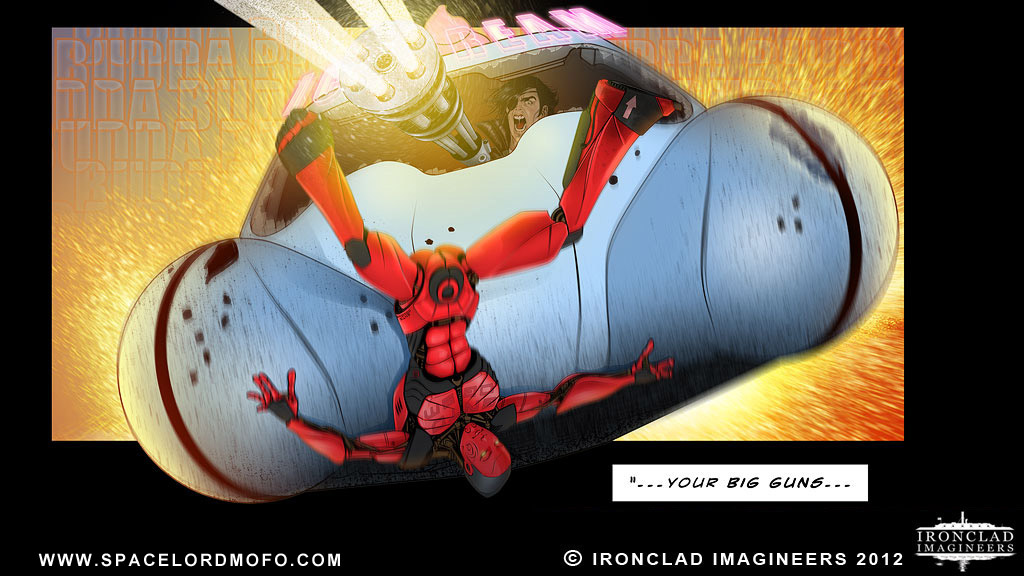
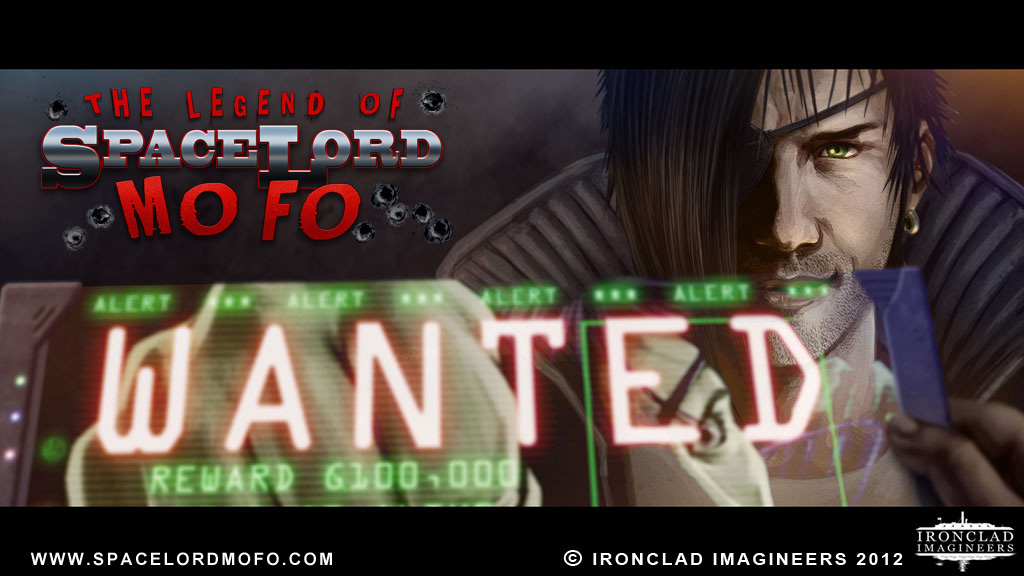
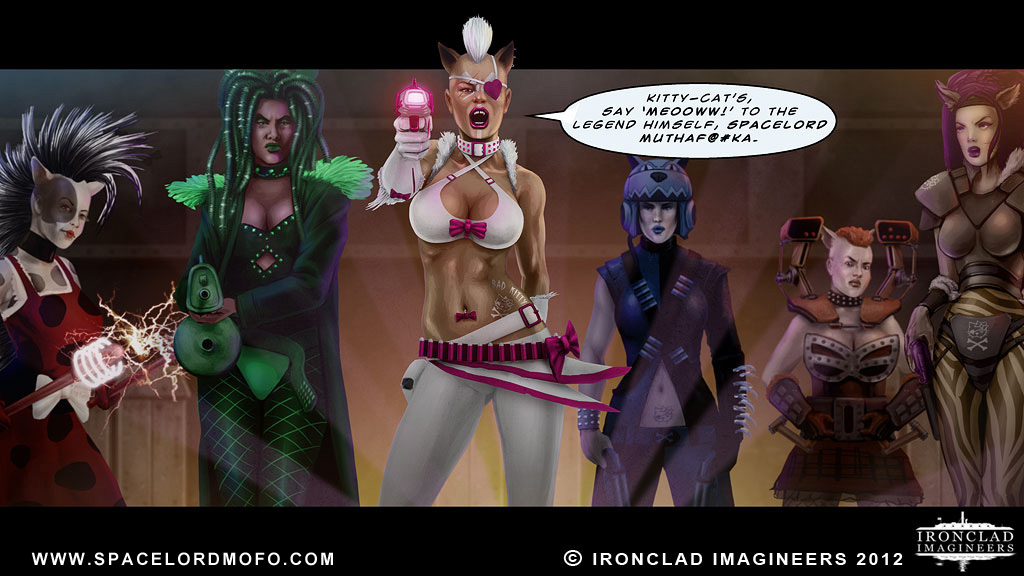
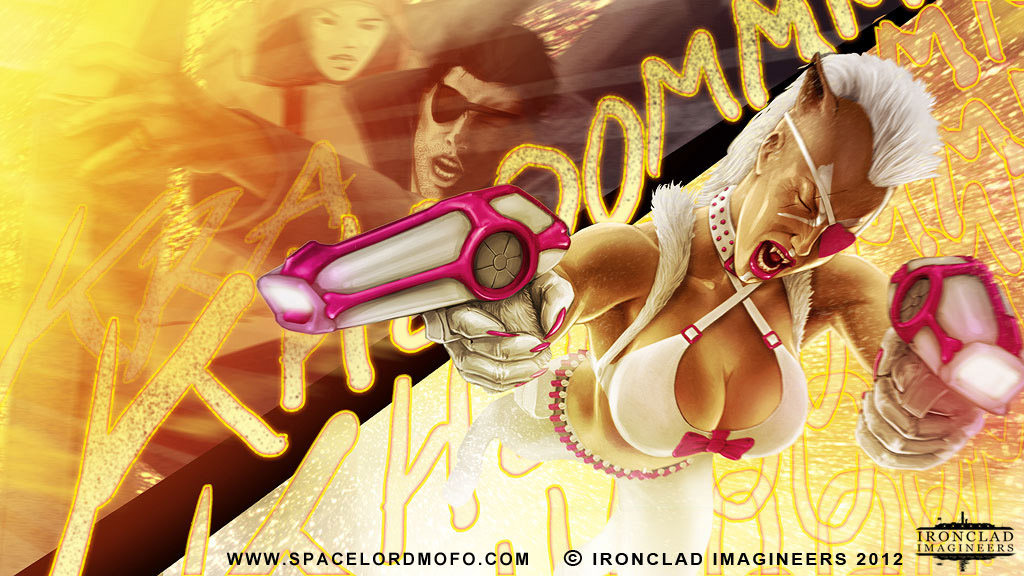



SDCC ’13 News: Angel Phoenix Media Acquires Trailblazing Digital Comic, The Legend of Spacelord Mo Fo | Pipedream Comics
July 20, 2013 @ 8:01 pm
[…] in February we interviewed the guys behind the awesomely titled The Legend of Spacelord Mofo – Pat McNamara a… – well today we’re pleased to announce that Angel Phoenix Media have acquired the Spacelord […]